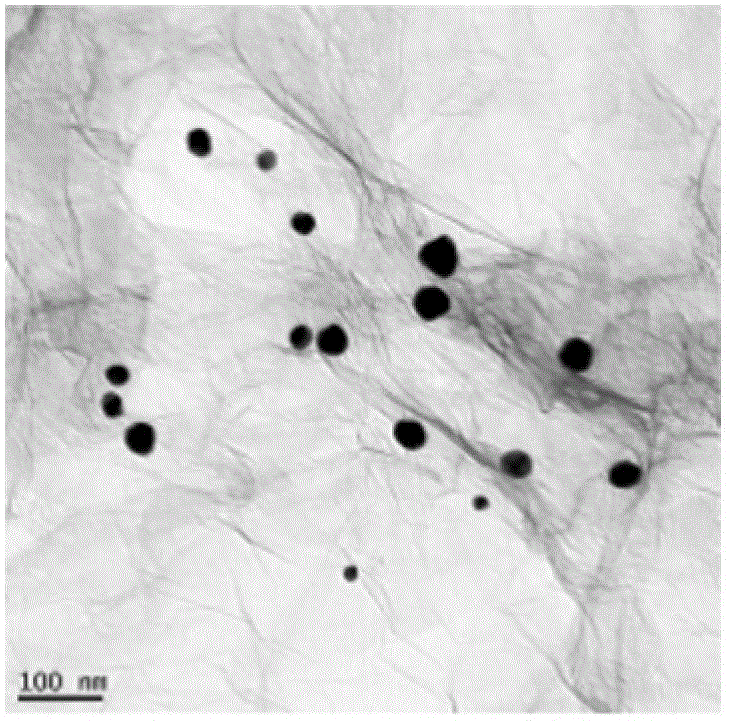Electrochemical biosensor for detecting bisphenol-A, and preparation method and application thereof
A biosensor, electrochemical technology, applied in the direction of material electrochemical variables, etc., can solve the problems of limiting the development of high-sensitivity detection technology, undisclosed bisphenol A electrochemical biosensor, large van der Waals force, etc., to achieve good production reproducibility , Improve electronic conductivity, enhance the effect of sensitivity
- Summary
- Abstract
- Description
- Claims
- Application Information
AI Technical Summary
Problems solved by technology
Method used
Image
Examples
specific Embodiment 1
[0022] An electrochemical biosensor for detecting the concentration of bisphenol A, the electrochemical sensor is a three-electrode system, wherein the counter electrode is a platinum electrode, the reference electrode is a saturated calomel electrode, and the working electrode is a graphene / gold - Tyrosinase-chitosan modified glassy carbon electrode (GR / Au-Tyr-CS / GCE).
specific Embodiment 2
[0023] A preparation method for an electrochemical biosensor for detecting bisphenol A, the specific steps are as follows:
[0024] (1) Preparation of graphene oxide
[0025] Mix potassium permanganate and flake graphite evenly at a mass ratio of 6:1 to obtain a mixed powder, mix concentrated sulfuric acid and phosphoric acid at a volume ratio of 9:1 to obtain a mixed solution, and mix the mixed powder and the mixed solution at a mass-volume ratio of 21g: 400ml Mix, then stir at 45-55°C for 10-14h, then cool to room temperature, add 3 / 400 mixed solution volume with a mass fraction of 30% H 2 o 2 Solution, after fully reacting to room temperature, use non-woven fabric suction filtration, the filtrate obtained after suction filtration is centrifuged at 4000rpm for 4h, the floating layer is poured off, and the solid matter obtained by centrifugation is sequentially used with equal amounts of deionized water, the mass fraction is 30% HCl solution, washed with ethanol, after e...
specific Embodiment 3
[0033] A method for the detection of bisphenol A with an electrochemical enzyme sensor based on graphene / gold complex-tyrosinase-chitosan (GR / Au-Tyr-CS)
[0034] The graphene / gold-tyrosinase-chitosan (GR / Au-Tyr-CS) mixture prepared in the above specific example 2 was modified onto the surface of the bare glassy carbon electrode, and the enzyme load was fixed on the surface of the glassy carbon electrode by adsorption. On the electrode surface, a platinum electrode is used as a counter electrode, and a saturated calomel electrode is used as a reference electrode to form an electrochemical enzyme sensor of a three-electrode system, and the enzyme sensor is composed. When the target analyte bisphenol A exists in the detection environment, an irreversible oxidation-reduction reaction occurs between the target and the tyrosinase immobilized on the electrode surface. As the concentration of the target increases, the response current also increases. The phenomenon detects the bisphen...
PUM
| Property | Measurement | Unit |
|---|---|---|
| Van Der Waals forces | aaaaa | aaaaa |
| quality score | aaaaa | aaaaa |
| quality score | aaaaa | aaaaa |
Abstract
Description
Claims
Application Information
 Login to View More
Login to View More - R&D
- Intellectual Property
- Life Sciences
- Materials
- Tech Scout
- Unparalleled Data Quality
- Higher Quality Content
- 60% Fewer Hallucinations
Browse by: Latest US Patents, China's latest patents, Technical Efficacy Thesaurus, Application Domain, Technology Topic, Popular Technical Reports.
© 2025 PatSnap. All rights reserved.Legal|Privacy policy|Modern Slavery Act Transparency Statement|Sitemap|About US| Contact US: help@patsnap.com



